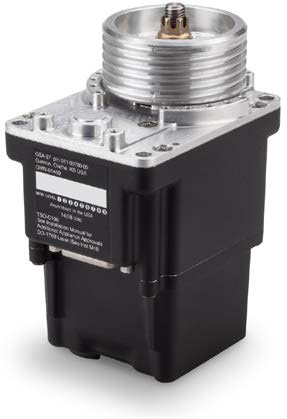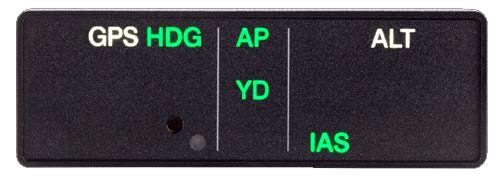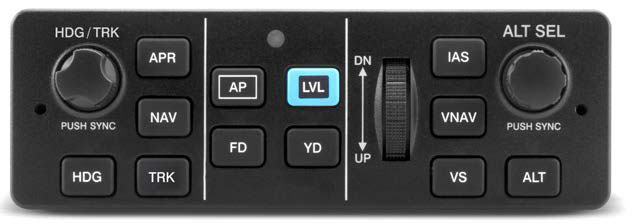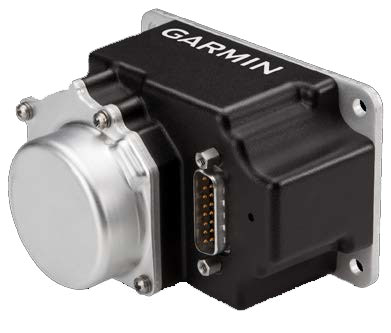Garmin Introduces GFC™ 600 and GFC 500 Autopilots
 Garmin is pleased to announce GFC 600 and GFC 500, solid state, attitude-based autopilots for fixed-wing general aviation aircraft. The unique designs of these autopilots deliver superior in-flight characteristics, self-monitoring capabilities and minimal maintenance needs when compared to older-generation autopilot systems. Boasting a robust feature set, GFC 600 and GFC 500 incorporate a number of technologies that can improve safety, such as Garmin ESP™ (Electronic Stability and Protection), underspeed protection, Level Mode, Flight Director (FD) and more. The GFC 600 autopilot is intended for high-performance piston single/twin-engine and turbine aircraft that have a wide range of aircraft speed and performance characteristics, while GFC 500 is intended for less complex piston single-engine aircraft. Built upon the acclaimed performance of the popular GFC 700 autopilot, GFC 600 and GFC 500 provide pilots with a suite of advanced autopilot capabilities that are an economical addition for a growing number of aircraft.
Garmin is pleased to announce GFC 600 and GFC 500, solid state, attitude-based autopilots for fixed-wing general aviation aircraft. The unique designs of these autopilots deliver superior in-flight characteristics, self-monitoring capabilities and minimal maintenance needs when compared to older-generation autopilot systems. Boasting a robust feature set, GFC 600 and GFC 500 incorporate a number of technologies that can improve safety, such as Garmin ESP™ (Electronic Stability and Protection), underspeed protection, Level Mode, Flight Director (FD) and more. The GFC 600 autopilot is intended for high-performance piston single/twin-engine and turbine aircraft that have a wide range of aircraft speed and performance characteristics, while GFC 500 is intended for less complex piston single-engine aircraft. Built upon the acclaimed performance of the popular GFC 700 autopilot, GFC 600 and GFC 500 provide pilots with a suite of advanced autopilot capabilities that are an economical addition for a growing number of aircraft.
GFC 600 Autopilot for High-performance Single/Twin-engine Piston and Turbine Aircraft

GFC 600 is designed as a standalone autopilot that boasts superior integration capability with G500 and G600 glass flight displays, Garmin navigators as well as a variety of third-party flight displays, instruments and navigation sources. The self-contained GMC 605 autopilot controller incorporates backlit keys and a bright, sunlight-readable display that depicts autopilot status and mode selection. An intuitive built-in control wheel also provides convenient adjustment of aircraft pitch, airspeed and vertical speed modes. When the level button is selected, the aircraft automatically returns to straight-and-level flight. Standard mark-width design of the GFC 600 autopilot controller allows for routine installation into the aircraft’s avionics stack.
 GFC 600 includes environmentally hardened GSA 87 autopilot servos designed for harsh operating conditions. The servos contain a brushless DC motor and a gear train that eliminates the need for a mechanical slip clutch, offering improved performance and reducing maintenance requirements when compared to decades old servo designs. If a G600/G500 flight display is not installed in the aircraft, an optional GI-285 autopilot annunciator panel can display the selected autopilot mode in the pilot’s primary field of view and retains an identical footprint of third-party autopilot annunciators on the market.
GFC 600 includes environmentally hardened GSA 87 autopilot servos designed for harsh operating conditions. The servos contain a brushless DC motor and a gear train that eliminates the need for a mechanical slip clutch, offering improved performance and reducing maintenance requirements when compared to decades old servo designs. If a G600/G500 flight display is not installed in the aircraft, an optional GI-285 autopilot annunciator panel can display the selected autopilot mode in the pilot’s primary field of view and retains an identical footprint of third-party autopilot annunciators on the market.  In the absence of a compatible airspeed and pressure altitude source, an optional air data module attaches to the backplate of the GMC 605. Initial Supplemental Type Certification (STC) for GFC 600 has been completed in the A36 Bonanza and B55 Baron aircraft with the 58 Baron and more aircraft models to follow.
In the absence of a compatible airspeed and pressure altitude source, an optional air data module attaches to the backplate of the GMC 605. Initial Supplemental Type Certification (STC) for GFC 600 has been completed in the A36 Bonanza and B55 Baron aircraft with the 58 Baron and more aircraft models to follow.
GFC 500 Autopilot for Certificated Single-engine Piston Aircraft
 Built upon the popular G5 electronic flight instrument, the GFC 500 autopilot integrates specifically with G5 to provide pilots with an economical autopilot and modern flight instrument (G5 is sold separately). The GMC 507 mode controller contains large, dedicated keys and knobs, a control wheel that allows for easy adjustments to aircraft pitch, airspeed and vertical speed and a level button that returns the aircraft to straight-and-level flight. Similar to GFC 600, the GSA 28 servos utilized on GFC 500 also contain brushless DC motors and gear trains that eliminate the need for a mechanical slip clutch.
Built upon the popular G5 electronic flight instrument, the GFC 500 autopilot integrates specifically with G5 to provide pilots with an economical autopilot and modern flight instrument (G5 is sold separately). The GMC 507 mode controller contains large, dedicated keys and knobs, a control wheel that allows for easy adjustments to aircraft pitch, airspeed and vertical speed and a level button that returns the aircraft to straight-and-level flight. Similar to GFC 600, the GSA 28 servos utilized on GFC 500 also contain brushless DC motors and gear trains that eliminate the need for a mechanical slip clutch.  G5 provides input and display of altitude preselect, heading, vertical speed target, airspeed target and Flight Director command bars for the GFC 500. The optional GAD™ 29 adapter allows GFC 500 and G5 to interface with select Garmin GPS or VHF navigators. Initial STC for GFC 500 is expected to be completed on select Cessna 172 aircraft models in the fourth quarter of 2017, with select Cessna 182 and Piper PA-28 aircraft models and more to follow.
G5 provides input and display of altitude preselect, heading, vertical speed target, airspeed target and Flight Director command bars for the GFC 500. The optional GAD™ 29 adapter allows GFC 500 and G5 to interface with select Garmin GPS or VHF navigators. Initial STC for GFC 500 is expected to be completed on select Cessna 172 aircraft models in the fourth quarter of 2017, with select Cessna 182 and Piper PA-28 aircraft models and more to follow.
GFC 600 and GFC 500 Feature Set: Cutting Edge Autopilot Design and Reliability
The full-featured GFC 600 and GFC 500 autopilots provide thousands of existing general aviation aircraft with a simple, light-weight, cost-effective autopilot upgrade path. GFC 600 and GFC 500 both incorporate solid state attitude with robust self-monitoring capabilities to provide superior autopilot performance, high reliability and stability benefits that are similar to the popular GFC 700 autopilot.
In addition to traditional autopilot capabilities such as altitude hold, vertical speed and heading, GFC 600 and GFC 500 also include the following features:
- Premium functions and advanced capabilities such as altitude pre-select1 and indicated airspeed hold mode; VNAV will be a growth function when appropriately equipped
- Pilots can select, couple and fly various instrument approaches, including GPS, ILS, VOR, LOC and back course approaches2,3
- Built-in GPS roll steering capability eliminates the need for external roll steering converters for smoother navigation tracking when installed with a compatible navigator
- Level Mode button, which automatically engages the autopilot to restore the aircraft to straight-and-level flight
- Underspeed protection helps prevent the pilot from stalling the aircraft if the autopilot is engaged in an inappropriate manner
- Overspeed protection helps prevent the pilot from exceeding aircraft maximum speed (VNE) if the autopilot is engaged in an appropriate manner
- With the addition of an optional yaw servo, Yaw Damping (YD) mode minimizes yawing oscillations while also helping to maintain coordinated flight by keeping the slip/skid indicator centered
- Flight Director command bars can be displayed on G5 with the GFC 500, while GFC 600 displays Flight Director on a variety of flight displays, such as G500 and G600
- Pilots can fly coupled ‘go-arounds’ during missed approach sequencing. A remotely-installed go-around button commands the Flight Director to display the appropriate pitch attitude required for the missed approach procedure and activates a loaded missed approach when paired with a GTN™ 650/750 navigator
- An optional pitch-trim servo adds automatic trim and manual electric trim
- Control wheel steering is available on GFC 600, which allows the pilot to adjust pitch, roll, altitude hold, vertical speed or airspeed references using the control yoke
Garmin ESP™ (Electronic Stability and Protection)
As a standard feature, pilots receive Garmin ESP with the GFC 600 and GFC 500 autopilots, which works to assist the pilot in maintaining the aircraft in a stable flight condition. Garmin ESP functions independently of the autopilot and works in the background to help pilots avoid inadvertent flight attitudes and provide airspeed protection while the pilot is hand-flying the aircraft. Should the pilot become inattentive and exceed pre-determined pitch, roll or airspeed limitations, Garmin ESP provides gentle nudges on the flight controls to lessen the aircraft’s pitch attitude or bank angle. The correcting force becomes stronger if the aircraft pitch, bank or airspeed exceedance grows further away from the preset limits. In the event the pilot becomes incapacitated and the system detects it has been activated for an extended period of time, the autopilot engages with the Flight Director in Level Mode, bringing the aircraft to level flight until the pilot commands otherwise. For maneuvering flight, Garmin ESP can be disabled manually.
8 years ago

